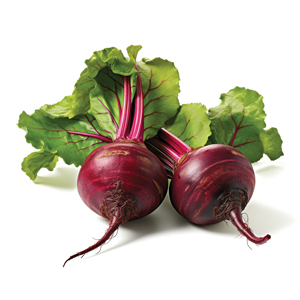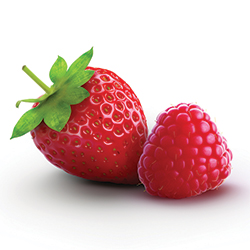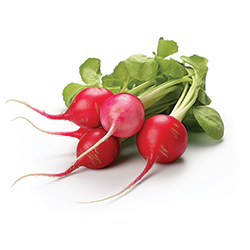
Vicki is a registered dietitian nutritionist, lifestyle nutrition expert, writer, culinary and media consultant and author of two books.
7 red foods to love, according to dietitians.
Love is in the air, so let’s color our plates with heart-healthy red foods. Red foods offer bold and powerful hues, and they come jam-packed with a bevy of health benefits.
From soft and crunchy to sweet and savory, these ruby reds contain an abundance of vitamins and minerals, plant-based compounds, and fabulous fiber. Here’s why dietitians sing their praises.
 Beets
Beets
As root vegetables, beets are powerful players in overall health. They contain antioxidants, anti-inflammatory compounds, and essential vitamins and minerals.
“Beets can decrease risk of diseases, such as type 2 diabetes, high blood pressure, and heart disease to name a few,” says Deb Ognar, a registered dietitian in Glenview, Illinois.
The red pigment in beets comes from plant compounds called betalains, which contain nitrates. “Nitrates convert to nitric oxide in the blood. This helps relax and dilate blood vessels, which improves blood flow to the heart and brain, making it helpful for cognitive function and blood pressure,” Ognar says.
It’s easy to get in the kitchen with beets, as you can purchase them pre-cooked, pickled, or juiced. Slice them into salads, soups, and sandwiches, or mix beet juice or beet powder into smoothies.
“For me, the easiest way to prepare them is whole or cut into cubes and roasted with a little olive oil, salt, and pepper,” says Christine Palumbo, a nutrition consultant in Naperville, Illinois.
 Strawberries and raspberries
Strawberries and raspberries
Both ruby red berries are famous for their disease-fighting nutrients. “These berries have vitamin C, fiber, and anthocyanins, which can help with decreasing inflammation, which in turn can help with the heart and boost memory,” Ognar says.
Low in calories, strawberries and raspberries contain 50 to 60 calories per cup. Plus, these little nutrient powerhouses, which consist of 90% water, are hydrating.
“Feel free to eat them daily. They’re often on sale in the produce aisle, and you can’t beat the convenience and price of frozen strawberries and raspberries to whirl into smoothies or to add to oatmeal,” Palumbo says.
 Radishes
Radishes
Crunchy and peppery, radishes are chock-full of plant-based goodness. “Radishes contain glucosinolates, which may protect against cancer,” Palumbo says. Plus, in these little cruciferous vegetables, you get lots of nutritional bang for your calorie buck: A medium radish has a mere one calorie and contains heart-healthy potassium and nitrates to keep blood pressure in check.
“They can easily be incorporated into everyday eating by add[ing] them to tacos, noodle dishes, grain bowls, and salads,” Ognar says.
 Pomegranates
Pomegranates
The pomegranate’s shiny red seeds — called arils — are nutrient-dense. They’re full of antioxidant flavonoids that prevent free radical damage, which may reduce the risk of certain cancers.
“Pomegranates contain fiber, vitamin C, vitamin K, and folate, which can help with regulating blood sugar and blood pressure,” Ognar says.
And there are so many fun ways to add them to your meals and snacks. Palumbo adds, “These little sparkling gems can be tossed into yogurt, salads, cereal, and overnight oats.”
 Bell peppers
Bell peppers
Of all the colors of bell peppers, red ones are the belles of the ball when it comes to vitamin C. “One cup of raw red bell peppers provides three times the daily value of vitamin C,” Palumbo says.
Plus, red bell peppers are loaded with disease-fighting carotenoids, such as vitamin A and beta carotene, as well as iron. “The nutrients can boost immune function, decrease inflammation and help with eye health,” Ognar says.
Red bell peppers are easy to roast in the oven or cook on the stovetop. Alternatively, add them raw and chopped to tacos, fajitas, stir fries, and egg dishes.
 Tomatoes
Tomatoes
Despite being used as vegetables, tomatoes are vine-grown fruits, which most commonly turn red when fully ripe.
Tomatoes boast antioxidants, such a vitamin A and vitamin C, as well as the antioxidant lycopene. As a matter of fact, processed tomato products are the primary source of lycopene in the American diet.
In cooking, tomatoes go well with a wide variety of dishes. Ognar uses fresh tomatoes in caprese salad, sandwiches, salsa, and marinara sauce, and she roasts them.
 Apples
Apples
Whether it’s a Red Delicious, Gala, or Honeycrisp, red apples offer a whole host of nutritional benefits for total body health. Just don’t skip the skin.
“The red skin is important as it contains half the fiber,” Palumbo says. Crunchy pomes are among the highest in dietary fiber or pectin with about 4 grams in a medium apple.
Plus, apples are loaded with plant compounds called polyphenols, which can fend off chronic disease states. “They can decrease inflammation, prevent constipation, lower LDL cholesterol, and prevent bowel disorders and certain cancers,” Ognar says.
Red apples are great for snacking. Palumbo suggests dipping them into nut butter. You can also slice them into wedges and top them with a thin slice of cheddar cheese. Chop them into salads or yogurt, or sprinkle them with cinnamon.
Go for heart-healthy reds to round out your fresh produce choices. “As part of your meals, aim to include half of your plate with fruits and vegetables, and consider including at least two servings a day of these red fruits and veggies,” Ognar says.








